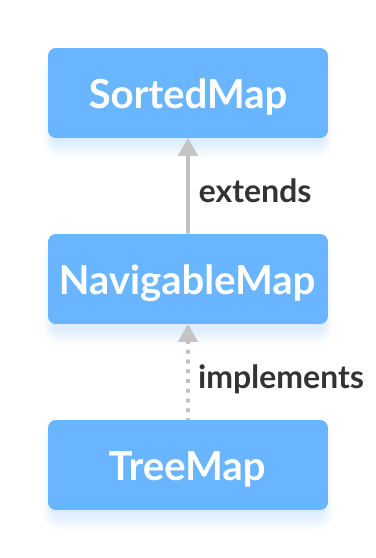| Methods |
Description |
| ceilingEntry(K key) |
Returns a key-value mapping which is associated with the least key which is greater than or equal to the specified key. Also, returns null if there is no such key. |
| ceilingKey(K key) |
Returns the least key which is greater than or equal to the specified key. Also, returns null if there is no such key. |
| descendingKeySet() |
Returns the reverse order NavigableSet view for the given keys which are contained in the map. |
| descendingMap() |
Returns the reverse order view of the mapping present in the map. |
| firstEntry() |
Returns a key-value mapping which is associated with the least key in the given map. Also, returns null if the map is empty. |
| floorEntry(K key) |
Returns a key-value mapping which is associated with the greatest key which is less than or equal to the given key. Also, returns null if the map is empty. |
| floorKey(K key) |
Returns the greatest key which is less than or equal to the given key. Also, returns null if the map is empty. |
| headMap(K toKey) |
Returns a view of the map whose keys are strictly less than the toKey. |
| headMap(K toKey, Boolean inclusive) |
Returns a view of the map whose keys are less than(if inclusive is true) the toKey. |
| higherEntry(K key) |
Returns a key-value mapping associated with the least key which is strictly greater than the given key. Also, returns null if there is no such key. |
| higherKey(K key) |
Returns the least key which is strictly greater than the given key. Also, returns null if there is no such key. |
| lastEntry() |
Returns a key-value mapping which is associated with the greatest key in the given map. Also, returns null if the map is empty. |
| lowerEntry(K key) |
Returns a key-value mapping which is associated with the greatest key less than the specified key. Also, returns null if the map is empty. |
| lowerKey(K key) |
Returns the greatest key such that it is strictly less than the given key. Also, it may return null if there is no key. |
| navigableKeySet() |
Returns a NavigableSet view of the keys which are contained in the map. |
| pollFirstEntry() |
Removes and returns a key-value mapping which is associated with the least key present in the map. Also, it may return null if the map is empty. |
| apollLastEntry() |
Removes and returns a key-value mapping which is associated with the greatest key present in the map. Also, it may return null if the map is empty. |
| subMap(K fromKey, Boolean fromInclusive, K toKey, Boolean toInclusive) |
Returns a view of the portion of the map whose keys may range from fromKey to toKey. |
| subMap(K fromKey, K toKey) |
Returns a view of the portion of the map whose keys may range from fromKey, inclusive to toKey, exclusive. |
| tailMap(K fromKey) |
Returns a view of the portion of the map whose keys are greater thantailMap(K fromKey, boolean inclusive) |
| tailMap(K fromKey, boolean inclusive) |
Returns a view of the portion of the map whose keys are greater than (or equal to) fromKey. |

